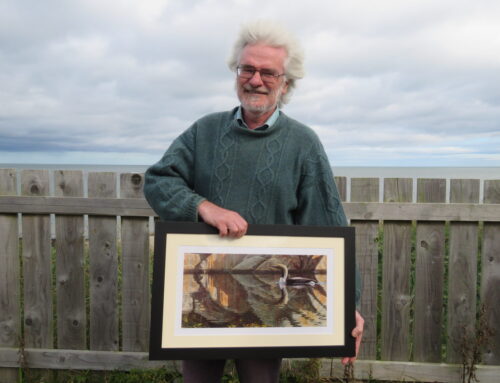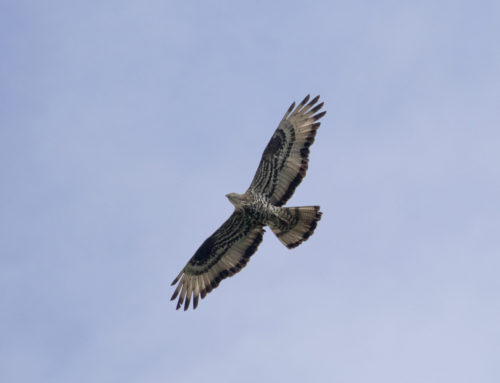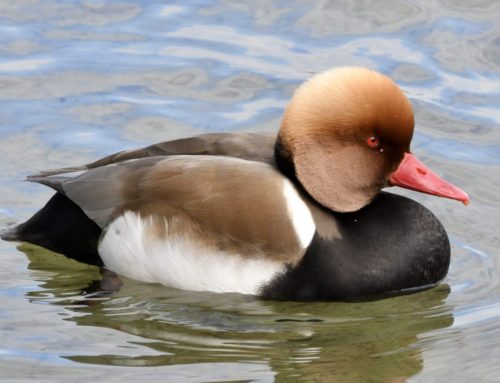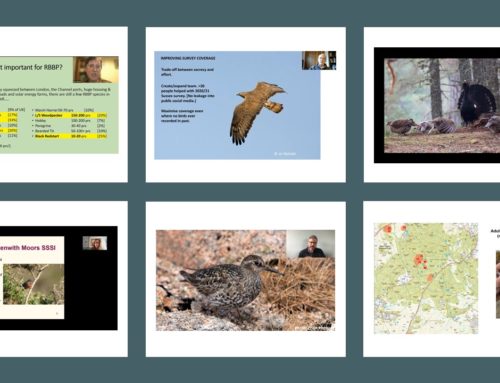Crested Tits – how rare are they?

Crested Tit by Ian Francis
The RBBP regularly reviews the list of species for which it collects data, to ensure our recording is fit for purpose and responsive to changes as populations rise and fall. We aim to cover all species with populations of fewer than 2,000 breeding pairs in the UK, but with a degree of pragmatism. For example, rapidly decreasing species such as Willow Tit and Turtle Dove have been added to the list recently despite recent estimates suggesting the populations may not (yet?) be below 2,000 pairs. Conversely, increasing species are not removed until we are confident an increase to above 2,000 pairs is likely to be sustained (for example, it is unlikely to drop again due to winter mortality events), and other factors, such as whether RBBP monitoring can still serve a valuable conservation purpose, are considered.
The Crested Tit was considered by the UK Rare Breeding Birds Panel between 1995 (although no data was submitted worth reporting upon until 1998) and 2005, but annually little useful information was submitted and there has been no assessment of its status since ‘Birds of Scotland’ (Cook in Forester et al. 2007). It is usually entirely confined to the Highland and Moray & Nairn bird recording areas, with occasional records elsewhere (most frequently North-East Scotland, but very rarely Argyll and Upper Forth). Taxonomically it is an endemic sub-species Lophophanes cristatus scoticus and its Scottish (and thus UK) breeding population is estimated at 1,000-2,000 pairs with a winter population of 5,600-7,900 individuals (Cook in Forester et al. 2007). This remains the most recent population estimate. There are thought to be some 6-12m pairs in a wide distribution across Europe.
Given this information, we recently considered whether Crested Tit should be reinstated on the Panel’s species’ list, and Ian Francis examined whether there was any data to suggest the estimate above was inaccurate, or that there has been any change since the Birds of Scotland assessment.
Change in population?
Cook in Forester et al. (2007) estimated the breeding population at around 1,362-1,954 pairs (c.1,700) using various assumptions, with a further c.700 unmated birds occupying territories, leading to c.2,400 occupied territories. This was rendered to an estimate of “probably fluctuating between 1,000 – 2,000 pairs” in 1993-1995. A survey during winters 1992/93 to 1994/95 showed that the population size was about 7,000 individuals in Scotland, comprising 2,900 winter groups (Summers et al. 1999); ‘a winter group is composed of a territorial pair plus the dispersed young from other pairs’ (Summers 2018). The latter statement does hold out the possibility that the population could be higher – up to 2,900 pairs if each pair from a winter group was to establish the following spring.
In the second BTO breeding bird atlas, the estimated total population was 900 pairs (Gibbons et al. 1993). While this may have been based on less detailed information and analysis than the estimate in Cook (2007), the period between 1968 and 1991 may have encompassed some range expansion (see below) so it is possible the population may have been lower prior to 1991 than in the 1990s onwards.
There is no clear support for any real recent change in population from local bird records. In Highland, there has been no obvious changes in status over 20 years; one local decline was noted (Boat of Garten area) but stability elsewhere (J. Poyner, pers. comm.). In Moray & Nairn, there is no meaningful information, nor any discernible trend. Numbers using nest boxes in some areas is variable but there is no trend (M. Cook, pers. comm.).
Crested Tits are recorded on a very limited number (annual five or fewer) of 1-km squares sampled in the UK Breeding Bird Survey, far fewer than are required to produce a robust trend. Coverage of BBS squares in Scotland has grown between 1994 and 2019 (245 to 606 squares), and this is presumably reflected in the increase in squares showing presence and numbers of Crested Tits found each year, although there has been a decline in the proportion of squares from which Crested Tits are recorded.
Change in distribution?
Using BTO atlas data, the breeding range appears to have shown a 28% increase since 1968-72, mainly west of the Great Glen, and the winter range showed a 50% increase since 1981-84 (Balmer et al. 2013). Local bird recorders suggest there is little evidence of change, however, recently. In Highland, there have been no obvious changes in status over 20 years (J. Poyner, pers. comm.) and in Moray & Nairn, there is no meaningful recent information, nor any discernible trend (M. Cook, pers. comm.). Crested Tits gradually colonised Moray & Nairn from their upper Speyside strongholds between c.1860 and 1940 (Cook, in prep.). This spread did not continue south-eastwards into Aberdeenshire but suggests a process which may have continued beyond that date, reflected by the BTO atlas range change figures above. There was also consolidation within range in Moray in the four decades before 2002-06 (Cook 2011).
In 2020, there have been several records in Deeside at Glen Tanar, with probable breeding suspected (C. McClean, pers. comm.). Although birds have appeared periodically in Deeside over the decades, this is the strongest evidence yet of an attempt at colonisation, though little is known about the spread or origin of the birds.
Is any other evidence available?
The ‘Online Scottish Bird Report’ (SOC website – https://www.the-soc.org.uk/about-us/online-scottish-bird-report ) details records from all recording areas, but no trend information can be derived. Similarly, annual RBBP reports between 1998 and 2005 (which can be seen in our revised ‘explore reports’ facility at https://rbbp.org.uk/explore-reports/) contained some summary information but nothing that can provide any population estimate or trends. BirdTrack has grown enormously in the number of records it receives over the past decade. Recent developments in the use of such unstructured data, potentially in combination with data from structured surveys (i.e. BBS) means that it may in time be possible to estimate some measure of trend, though a population estimate is unlikely to be possible using this data source. Finally, some information may be available from birds counted on RSPB winter Capercaillie surveys, but those figures have not been analysed (N. Wilkinson pers. comm.) and of course are derived from a survey stratification based on Capercaillie distribution and not the range of Crested Tit.
Conclusion – Crested Tit back on the RBBP species’ list
The population estimate in Cook (2007) is derived using certain assumptions about mortality in winter groups, with the number of winter groups based on data from the winter survey of Summers et al. (1999) and a further adjustment for territories held by unmated birds. This more convoluted estimate is then simplified with a conservative and very rounded figure of 1,000 – 2,000 pairs – a very wide range. It is hard to contest this, although the definition of winter groups does hold out the possibility of a larger population of up to 2,900 pairs. However, reworking the calculation method seems unlikely to yield something radically different from the very general figure of 1,000 – 2,000 pairs.
There is no strong evidence for any recent change in population size of Crested Tit from any source. BBS data hint at a possible decline in abundance in a very small number of sample squares, but this is an insufficient basis for any firm conclusions. By contrast, more robust range indicators between BTO Atlas years suggest expansion of breeding range, which logically suggests a numerical increase, and suggestions of range consolidation in Moray may also suggest local increases – if we assume densities within the occupied range have remained stable. But neither of these are definitive.
In short, the population estimate we have is probably as good as it can be based on the information available, and there is little that can be derived from any other source that suggests it is incorrect. Despite evidence of range increase, there is no reliable information that supports any population change – though it is possible there has been an undetected population increase to accompany this. The current and very broad estimate of 1,000 – 2,000 pairs seems destined to remain valid.
In conclusion, Crested Tit currently appears to belong on the RBBP’s species’ list and will be reinstated from the breeding season of 2020 onwards; we will be asking data providers to include Crested Tit records in the data for 2020 submitted to the Panel in late 2021. We would thus encourage all birdwatchers to ensure any records of Crested Tits from the 2020 breeding season are submitted to the relevant county bird recorder (which can be done via BirdTrack). As with all rare breeding bird records, submissions should include details of breeding evidence (see http://box2010.temp.domains/~ukrbbpor/wp-content/uploads/2020/03/rbbp-recording-standards.pdf) as well as precise location details.
Crested Tit was dropped from the RBBP list in 2005 on the basis that “data received are insufficient to provide any meaningful statistics on the population in Scotland”. That may well remain the case when the species rejoins the list, but should not considered a valid reason to exclude it: the same is true for a number of other species on the species’ list for which only a small proportion of the population is reported each year e.g. Greenshank and Snow Bunting. Data for such species can still be of use, for example in mapping occurrence and distribution change particularly on the edge of the range, in identifying important sites, and for informing the design of future surveys or other studies. In addition, by returning Crested Tit to the list we can hope to improve the attention paid to this undoubtedly charismatic and popular species, so we anticipate that in time the volume and hence value of the data submitted will increase.
Ian Francis & Mark Eaton
Acknowledgements
Malcolm Ausden, Martin Cook, Colin McClean, John Poyner, Ron Summers, Nick Wilkinson.
References
Balmer, D.E., Gillings, S., Caffrey, B.J., Swann, R.L., Downie, I.S. & Fuller, R.J. (2013) Bird Atlas 2007-11. BTO, Thetford.
Cook, M., in Forrester, R., & Andrews, I. (2007) The Birds of Scotland. SOC, Aberlady.
Cook, M., in Francis, I, & Cook, M. (2011) The Breeding Birds of North-East Scotland. An atlas of the breeding birds of Aberdeen, Aberdeenshire and Moray. SOC, Aberlady.
Cook, M. (in prep). Birds of Moray & Nairn – their status and where to find them.
Gibbons, D.W., Reid, J.B. & Chapman, R.A. (1993) The new atlas of breeding birds in Britain and Ireland: 1988-1991. T. & A.D. Poyser, London.
Summers, R.W. (2018) Abernethy Forest: The History and Ecology of an Old Scottish Pinewood. RSPB, Sandy.
Summers, R.W., Mavor, R.A., Buckland, S.T. & MacLennan, A.M. (1999) Winter population size and habitat selection of Crested Tits Parus cristatus in Scotland. Bird Study, 46: 230-242, DOI: 10.1080/00063659909461135






